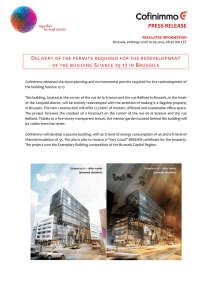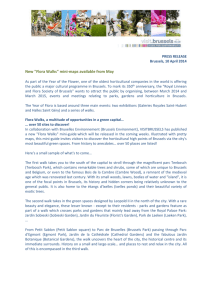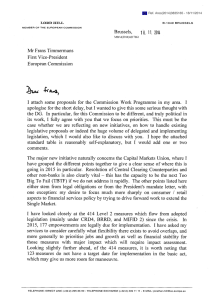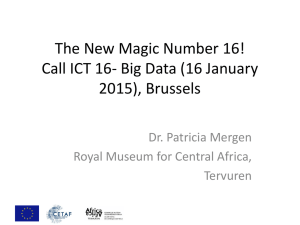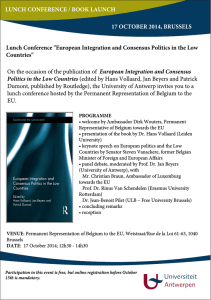Les Parcs de Bruxelles dans les Galeries Royales Saint
advertisement
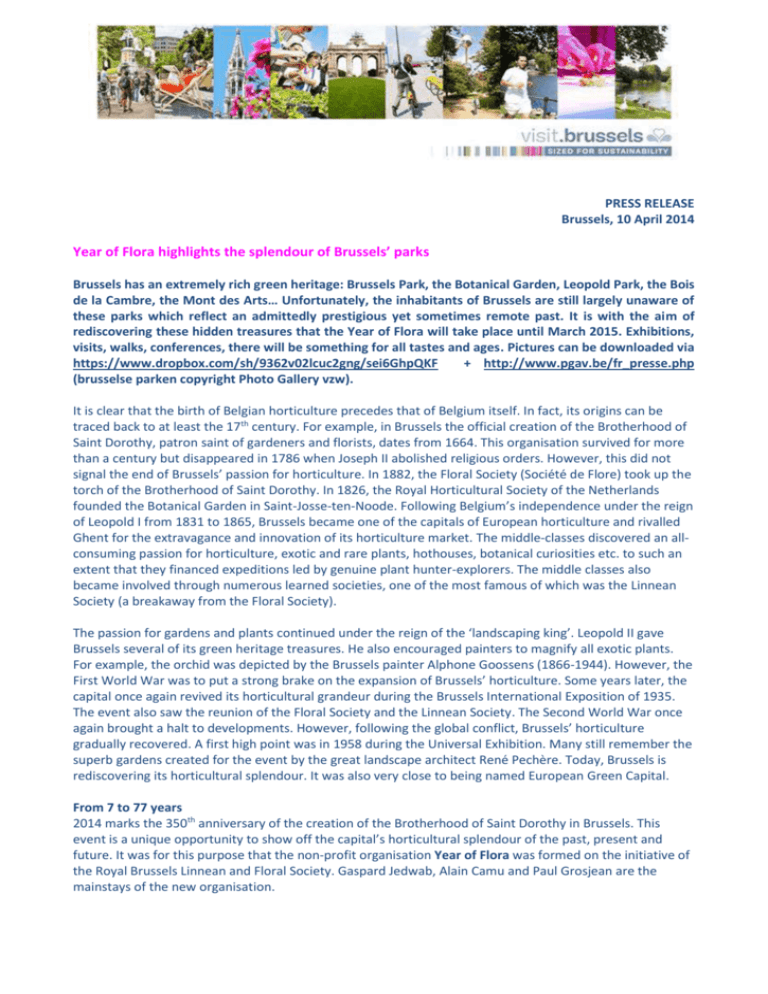
PRESS RELEASE Brussels, 10 April 2014 Year of Flora highlights the splendour of Brussels’ parks Brussels has an extremely rich green heritage: Brussels Park, the Botanical Garden, Leopold Park, the Bois de la Cambre, the Mont des Arts… Unfortunately, the inhabitants of Brussels are still largely unaware of these parks which reflect an admittedly prestigious yet sometimes remote past. It is with the aim of rediscovering these hidden treasures that the Year of Flora will take place until March 2015. Exhibitions, visits, walks, conferences, there will be something for all tastes and ages. Pictures can be downloaded via https://www.dropbox.com/sh/9362v02lcuc2gng/sei6GhpQKF + http://www.pgav.be/fr_presse.php (brusselse parken copyright Photo Gallery vzw). It is clear that the birth of Belgian horticulture precedes that of Belgium itself. In fact, its origins can be traced back to at least the 17th century. For example, in Brussels the official creation of the Brotherhood of Saint Dorothy, patron saint of gardeners and florists, dates from 1664. This organisation survived for more than a century but disappeared in 1786 when Joseph II abolished religious orders. However, this did not signal the end of Brussels’ passion for horticulture. In 1882, the Floral Society (Société de Flore) took up the torch of the Brotherhood of Saint Dorothy. In 1826, the Royal Horticultural Society of the Netherlands founded the Botanical Garden in Saint-Josse-ten-Noode. Following Belgium’s independence under the reign of Leopold I from 1831 to 1865, Brussels became one of the capitals of European horticulture and rivalled Ghent for the extravagance and innovation of its horticulture market. The middle-classes discovered an allconsuming passion for horticulture, exotic and rare plants, hothouses, botanical curiosities etc. to such an extent that they financed expeditions led by genuine plant hunter-explorers. The middle classes also became involved through numerous learned societies, one of the most famous of which was the Linnean Society (a breakaway from the Floral Society). The passion for gardens and plants continued under the reign of the ‘landscaping king’. Leopold II gave Brussels several of its green heritage treasures. He also encouraged painters to magnify all exotic plants. For example, the orchid was depicted by the Brussels painter Alphone Goossens (1866-1944). However, the First World War was to put a strong brake on the expansion of Brussels’ horticulture. Some years later, the capital once again revived its horticultural grandeur during the Brussels International Exposition of 1935. The event also saw the reunion of the Floral Society and the Linnean Society. The Second World War once again brought a halt to developments. However, following the global conflict, Brussels’ horticulture gradually recovered. A first high point was in 1958 during the Universal Exhibition. Many still remember the superb gardens created for the event by the great landscape architect René Pechère. Today, Brussels is rediscovering its horticultural splendour. It was also very close to being named European Green Capital. From 7 to 77 years 2014 marks the 350th anniversary of the creation of the Brotherhood of Saint Dorothy in Brussels. This event is a unique opportunity to show off the capital’s horticultural splendour of the past, present and future. It was for this purpose that the non-profit organisation Year of Flora was formed on the initiative of the Royal Brussels Linnean and Floral Society. Gaspard Jedwab, Alain Camu and Paul Grosjean are the mainstays of the new organisation. Year of Flora is under the High Patronage of Her Majesty Queen Paola. It is also receiving the welcome support of a number of partners from the Brussels Capital Region, the City of Brussels, Bruxelles Environnement, Visit Brussels, Botanic Garden Meise, les Halles Saint-Géry, Espaces Verts et Art des Jardins, RTBF/La Première, VivaBruxelles, the Royal Galleries of St. Hubert, Floralia Brussels, Arbor and AG Real Estate. Year of Flora was officially opened on Thursday 10th April in the presence of many leading figures brought together for the occasion at the Château de Grand-Bigard as part of the exceptional Floralia Brussels exhibition. Between spring 2014 and spring 2015, Year of Flora will be organising or promoting a certain number of events dedicated to the parks and gardens of Brussels including exhibitions, visits and conferences. These events will be directed at a large public audience, from 7 to 77 years, both French- and Dutch-speaking. Tourists will also be targeted. And not forgetting enlightened amateurs, of course. Year of Flora begins in the Royal Galleries of St. Hubert. With the support of the non-profit association Photo Gallery, there will be an exhibition devoted to the Brussels parks. Giant photos created especially for the event will be hung from the wonderful glass roof until 8th May. The Queen’s Gallery and the King’s Gallery will be decorated with flowers thanks to Floralia Brussels. All passers-by will be able to discover – free of charge and in fine style – the horticultural splendour of the capital city. This exhibition is a unique opportunity to bring the parks and gardens into the Brussels urban space. Following the exhibition in the Royal Galleries of St. Hubert, there will be the “Balades de Flore” organised by Bruxelles Environnement and Visit Brussels. From May until October, the public will be able to visit this fine heritage immortalised by Photo Gallery. Maps showing various routes for discovering the Brussels Capital Region and its green spaces will be made available to those who would like them. Three zones will be created in the North, Centre and South of the city. These will include the capital’s most beautiful public parks: Mont des Arts, Brussels Park, Egmont Park, Petit Sablon, Leopold Park, Jardins du Fleuriste, Bois de la Cambre, Botanic Garden, Square du 21 juillet, Sobieski Park, Jardin Colonial, Osseghem Park, Garden of the Chinese Pavilion… Guided tours will be led by the non-profit association CAP. The guides will be accompanied by renowned experts including Denis Diagre, Odile De Bruyn, Daniel Geerinck and Wolfgang Vahsen. A true societal challenge Finally, the climax of the Year of Flora will take place from 10th December to 28th February 2015 in the Halles Saint-Gery in the form of the exhibition “Bruxelles, Capitale de Flore” (Brussels, Floral Capital). The exhibition will paint a broad picture of horticulture and floriculture in the capital from the 17th century to the present day. In particular, it will emphasise the horticultural splendour of the city between 1831 and 1865 in which the Linnean Society and the Floral Society were highly involved. It will reveal an unexpected side of the 19th century middle-classes. Suspense… It will also highlight an emblematic plant of this bourgeoning era: the orchid as immortalised by the painter Alphonse Goossens. The painter’s greatgranddaughter, Véronique Goossens, in a nod to her grandfather, has been entrusted with the project of creating an installation entitled (IN)SOUTENABLE. The exhibition will finish with some more contemporary elements. The highlights of the current parks and gardens will be tackled together with Bruxelles Environnement. All of the exhibitions panels and notices will be in 3 languages: French, Dutch and English. Exhibition in the Royal Galleries of St. Hubert, Balades de Flore, exhibition Bruxelles, Capitale de Flore, Year of Flora will be organising a number of events. However, this will not prevent it from promoting all the other related events held in Brussels and its surroundings. Via its website, it will highlight multiple projects concerning the parks, gardens, flowers and plants: Open Doors Day at the Institute Redouté-Peiffer, flower carpet at the Grand Place in Brussels, Jardins en fête by the René Pechère Library, conferences at CIVA with Espaces Verts et Art des Jardins, exhibition at the Archives de la Ville de Bruxelles, discovery of wild orchids in Brussels… In addition to these events, the organisers of Year of Flora want to send a strong message to public opinion: the parks and gardens are a great challenge for Brussels. The challenge is simultaneously cultural, educational, environmental, economic, touristic and sectoral. Those supporting these events support this message. Hence the reason that Year of Flora will finish with a round-table discussion in which all stakeholders will come together in order to map out the future of Brussels’ parks and gardens. We are already thinking of the future beyond Year of Flora! For more information on Year of Flora and to register for the various events, please visit: www.year-of-flora.be Press service: Michel Grossmann: 0477-337.302. / michel@flconsult.be

